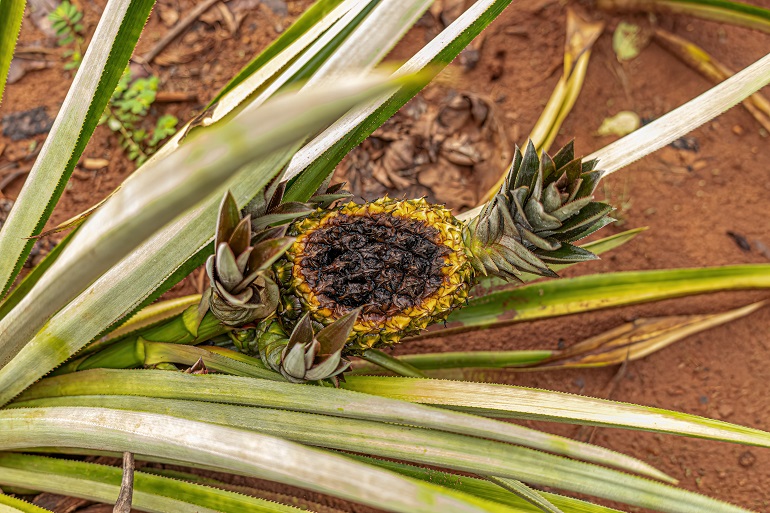Pineapple Crop Protection

This post is also available in:
This post is also available in:
![]() Español (Spanish)
Español (Spanish) ![]() Français (French)
Français (French) ![]() Deutsch (German)
Deutsch (German) ![]() हिन्दी (Hindi)
हिन्दी (Hindi) ![]() العربية (Arabic)
العربية (Arabic) ![]() 简体中文 (Chinese (Simplified))
简体中文 (Chinese (Simplified)) ![]() Português (Portuguese (Brazil))
Português (Portuguese (Brazil))
Pineapple Pests, Diseases, Physiological Disorders and Weed Management
Pineapple crop protection
Like many other crops, pineapples are greatly affected by both biotic and abiotic stresses, which significantly reduces crop yields if proper care is not given in time. This article explains the economically significant biotic and abiotic stresses that pineapple farmers should take into consideration.
Major Pests of pineapples
i)Nematodes
Plant-parasitic nematodes are prevalent wherever pineapple is produced and are one of the most significant problems for global pineapple production (1). Nematodes can infest and harm both the primary and secondary roots, negatively affecting the plant’s ability to absorb nutrients and water. This results in yield reduction. The three most common plant parasitic nematodes that infest pineapples are root-knot nematodes, reniform nematodes, and lesions nematodes. Fumigation of the soil before planting can be used to control nematode problems, but it is not an environmentally sustainable solution. As a result, alternative methods, such as crop rotation with non-host crops or adapting longer crop breaks, play an important role in reducing nematode populations. During breaks, cover crops like sunn hemp (Crotalaria juncea) can be used to suppress the population of nematodes.
ii)Arthropods
Arthropods are found both on and above the ground and can cause a significant loss in pineapples because they are also vectors of diseases. Many arthropods affect pineapples, but the following are the ones with the higher economic significance.
- Pineapple leathery pocket mite/pineapple fruit mite, Steneotarsonemus ananas (Tryon). The pineapple-leathery pocket mite/pineapple fruit mite is host-specific to pineapples and can be found worldwide. Fruit mites attack the vase base of young heart leaves and the bracts and sepals of developing fruits. The effective control can be achieved with foliar sprays with a solution of 140 ml of endosulfan 350 EC/ 100 L of water
- Pineapple flat mite/pineapple red mite (Dolichotetranychus floridanus (Banks).
Even though the pineapple flat mite/pineapple red mite has been found in almost all pineapple production areas like Central America, the Philippines, Brazil, Hawaii, Cuba, Taiwan, India, South Africa, and Australia. To effectively control this pest, farmers apply foliar sprays with systemic organophosphate pesticides or 6 l dimethoate 400 g l−1 EC in 2,000 l water per hectare (Petty et al., 2002).
iii)Symphylids
Symphylids (Scutigerella spp. and Hanseniella spp) are pineapple-associated myriapods that feed on the roots and have been reported to be of significant economic importance in Martinique, Costa Rica, Brazil and Australia, and the Ivory Coast (2). To control myriapods, fumigation with methyl bromide gas is highly effective.
Important Diseases of pineapple and their Management
Diseases that cause economically significant losses in pineapples often attack the fruit. Pineapple management is challenging because of the wide variety of microorganisms that attack mainly the surface and internal parts of the developing inflorescence (3). The following are examples of economically important fruit diseases:
- Black rot, causd by Ceratocystis paradoxa.
- Fruit collapse caused by Erwinia chrysanthemi.
- Fruitlet core rot is caused by a complex combination of pathogens and vectors like Penicillium funiculosum, Fusarium guttiforme, Candida guilliermondii, the pineapple fruit mite Steneotarsonemus ananas, and the pineapple red mite Dolichotetranychus floridanus.
- Internal browning (black heart) caused by Acetobacter peroxide, Acetobacter sp., and Pantoea ananatis.
These diseases are mainly controlled by controlling the (insect) vectors through pesticide applications. Keep in mind that the availability of the products mentioned (pesticides, fungicides, etc.) highly depends on local legislation.
Physiological disorders – Abiotic Stresses
Sunburn
Due to high solar radiation in the tropics, sunburn is a big abiotic problem that affects pineapples, especially during fruit maturation and shortly before harvest. Yield losses caused by sunburn vary according to the level of solar radiation each production region has and the harvest season, becoming more severe during the summer, especially when there are prolonged high temperatures during the day. To control sunburn, pineapple growers protect the developing fruits by covering them with paper (4).
Weed management
Weed problems become one of the most critical tasks that increase production costs due to pineapples’ slow growth (5). Whether a single-row or double-row planting system is used, hand weeding or using a hoe might be challenging, especially in double-roll cropping. On the other hand, the double-roll system is better than the single-roll system because it makes it harder for weeds to grow. In general, two methods are wildely used in large plantations for weed control, as follows:
- The herbicide has proven to increase yield by 20 to 40 %. The herbicide selection depends on the restriction level and legislation of each country.
- The use of plastic cover, which significantly reduces the presence of weeds, is highly recommended; however, even with plastic, some weeds, such as those in the Cyperaceae family, can still overcome the cover. On very rare occasions that this happens, hand-pulling these weeds is highly recommended, but with great care not to destroy the plastic.
References
[1] Petty, G. J., Stirling, G. R., & Bartholomew, D. P. (2002). Pests of pineapple. Tropical fruit pests and pollinators: their economic importance, natural enemies, and control. CAB International, Wallingford, 157-196. http://sherekashmir.informaticspublishing.com/378/1/9780851994345.pdf#page=181
[2] https://www.ishs.org/ishs-article/
[3] Rohrbach, K. G., & Schmitt, D. (2003). Diseases of pineapple. Diseases of tropical fruit crops, 443-464. https://www.cabidigitallibrary.org/doi/abs/10.1079/9780851993904.0443
[4] De Matos, A. P., & Reinhardt, D. H. (2009). PINEAPPLE IN BRAZIL: CHARACTERISTICS, RESEARCH AND PERSPECTIVES. Acta Horticulturae, (822), 25–36. doi:10.17660/actahortic.2009.822
[5] Eshetu, T., Tefera, W., & Kebede, T. (2007). Effect of weed management on pineapple growth and yield. Ethiopian Journal of weed management, 1, 29-40. https://www.researchgate.net/
Pineapple History, Uses and Nutritional Value
Pineapples Plant Information and Environmental Requirements
Soil Requirements and Land Preparation for Pineapple
Planting of Pineapple – Pineapple Plant Density
Pineapple Water Needs and Irrigation Systems
Pineapple Fertilization Requirements
Pineapple Flowering, Pollination, and Pruning
Pineapple Crop Protection








































































